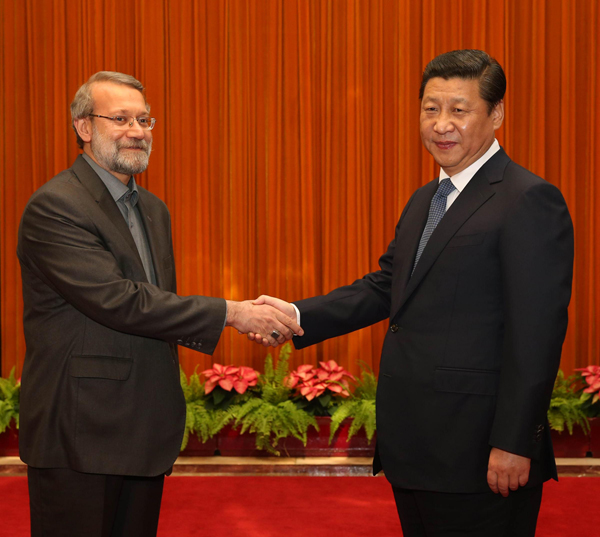 President XiJinping and Iranian Speaker Ali Larijani (Photo: FMPRC)
President XiJinping and Iranian Speaker Ali Larijani (Photo: FMPRC)
by David Parmer
These days, China- Iran relations center on two key points: oil and trade. China is Iran’s biggest customer for crude oil. Iran has been hard hit with U.S. sanctions that have frozen assets and crippled its oil industry. Sanctions are aimed at Iran’s nuclear program, which Iran claims is designed for peaceful energy production, while countries around the world, led by the U.S. see it as a cover for the development of nuclear weapons.
On November 20, 2013, China’s president, XiJinping urged his Iranian counterpart to “seize the opportunity” to improve relations with other world powers at the third round of the current Geneva meetings.
In October, both China and South Korea cut imports of Iranian crude; China to stay within agreed U.S. guidelines. The Financial Times reported on November 22, 2013 that in October 2013 there was a 45% decline in Iranian crude exports, and a resulting cutback in production. Crude oil accounts for 80% of Iran’s exports and half of the Iranian government’s income.
Clearly the pressure is on Iran to come and make some concessions at the Geneva meetings in exchange for easing of sanctions and partial un-freezing of its international assets.
The Obama administration is gambling that it can deal with the less-hardline regime of President Hassan Rowhani. Opposition to any deal comes from Israel and Saudi Arabia. In a world economy experiencing a certain slowdown, a deal to allow Iran greater oil exports could cause a glut in the market and drive down prices worldwide.
As for non-oil trade, Iranian Customs reported $4.06billion worth of exports to China, while Iran imported $5.7billion from China in the first eight months of 2013. One area of China-Iran friction centers around complaints that cheap Chinese goods have flooded the Iranian market seriously damaging smaller Iranian concerns. While China-related infrastructure projects already exist, there is sentiment for more of that type of activity as opposed to the inflow of cheap goods. Moreover, since China pays for Iranian petroleum in Yuan (RMB), Iran’s payments are locked in China’s banks. Estimates of these funds range from $20-47 billion. Reports quoted Iran’s Tasnim News as saying that a deal had been struck between China and Iran during meetings in October 2013 with Speaker Ali Larijani and Chinese leaders in Beijing to fund development projects in Iran using some $22billion of the above-mentioned funds.
(This report was compiled from various Web sources)
 日本語
日本語 English
English 中国語
中国語